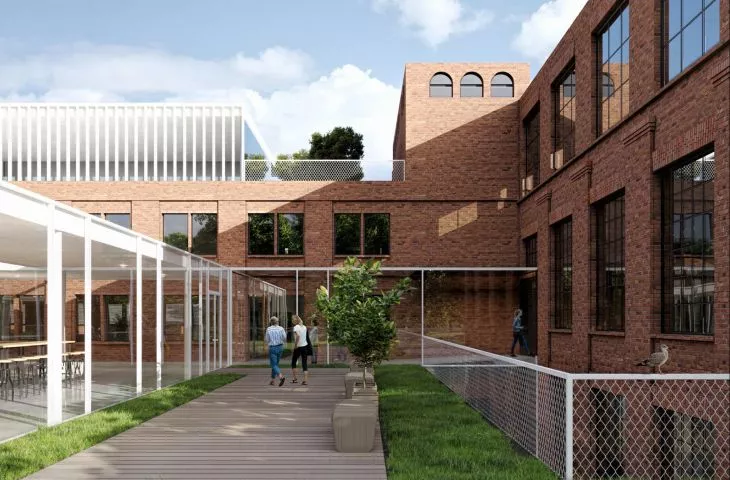The deteriorating condition of the planet makes us reflect on the attitude that an architectural artist should take in the climate crisis. One way to reduce the negative impact of humans on the environment is to promote the values that characterize craft products, which are forgotten today. This can contribute to reducing the production of waste resulting from ill-considered purchases of mass-produced goods.



view of the bastion
© Karolina Jankowska
The subject of the work is the project of the New School of Arts and Crafts based on the idea of upcycling. According to it, students during classes in the school's workshops will use used everyday objects delivered to them as raw materials for their work, giving them a second life. To refer to the idea of upcycling also in architecture, it was decided to implement the developed functional model of the New School on the example of the adaptation of a complex of buildings in the Lower Town in Gdansk.



eastern silhouette of the premise
© Karolina Jankowska
In addition to the pro-environmental dimension of the work, an attempt was made to draw attention to the problem, which is the small share of practical classes in relation to theoretical classes in art and architecture faculties. To this end, in the adapted building it was decided to combine the school function with an office function for the creative industries. In this way, the possibility of cooperation and collaboration between students and those actively working in the profession was provided. In designing the functional solutions in the building, direct inspiration came from the innovative assumptions and solutions of the Bauhaus School in Dessau as an iconic school combining various fields of art and forms of education.



floor plan of the +1 floor of the main building
© Karolina Jankowska
functional division
The project adopted five buildings built in the mid-19th century located on the territory of the Teddy Bear Bastion in Gdansk. In the largest of them, the old factory building, the function of the New School of Arts and Crafts was developed, as well as coworking spaces for rent for offices from the creative industry. The entire building, in accordance with the idea of functionalism, has been divided into wings for mental work, manual work, common spaces and spaces for rent.



C-C cross-section
© Karolina Jankowska
The remaining brick buildings on the plot were allocated for the function of catering, an exhibition hall for a fair for local residents, the function of a "Po-distribution room", i.e. a sorting room for used materials and space for exchanging used items, the function of a kindergarten for employees' children and the function of a cafe with a bicycle service.
The main factory building was added one floor to equalize the heights between the two wings of the building. The courtyard space was also built up to house a two-story exhibition space and an auditorium. For the use of students, the school section houses a carpentry workshop, metalwork workshop, weaving workshop, model room, painting studio, 3D printing studio and photo-video studio. A library and spaces for design studios for students and their mentors have been located in the superstructure. In keeping with the ideas of the Bauhaus, this procedure is intended to erase the existing barrier between lecturers and students, creating space for them to work together. The first floor of the existing building has been mostly dedicated to the public functions of a café and a store for student work.
Left: coworking space; right: café
© Karolina Jankowska
design solutions
The extension of the building was proposed in a minimalist glass form to clearly distinguish the new part from the old building fabric and to emphasize its values. The form of the glass courtyard was designed to preserve the existing state of the bastion's tree canopy. The designed development gently surrounds the existing greenery, creating a kind of glass cubicle. In addition to their pro-environmental value, they perform the function of illuminating the interior of the courtyard. At the level of the underground storey, under the roots of the trees, there are retention tanks for rainwater. The premise of the project is to propose a harmonious and gentle interference with the existing structure, and to provide open, well-lit spaces that connect to the green recreational areas of the bastion.
The 


exhibition space
© Karolina Jankowska
The structural layout of the building was preserved as much as possible. It was decided to demolish some of the ceilings locally and change the structural layout of the load-bearing walls to a columnar system, with the aim of creating open and flexible spaces. The northern wing of the building, with its hall-like layout, offers large-scale space. Taking advantage of these conditions, a venue for events - concerts, conferences, design and fashion fairs - was proposed here. It is assumed that one of the main users of these spaces will be employees of the neighboring LPP company campus on Łąkowa Street.



auditorium
© Karolina Jankowska
Among the main goals of the project is to improve the functioning of this part of the degraded Dolne Miasto district by fitting in with the slogan of the activities carried out by the City of Gdansk within the district area since 2004 - "revitalization with art". The variety of functions in the adapted buildings affects the creation of a vibrant public space within the bastion, attractive to a wide range of users at different times of the day. In addition, an arm of the bastion has been earmarked for recreational areas for the district's residents.
Karolina JANKOWSKA
© Author



















































































